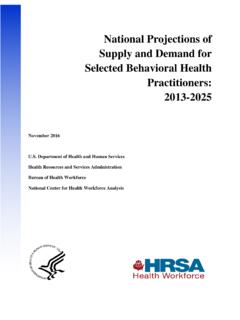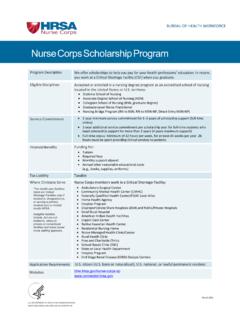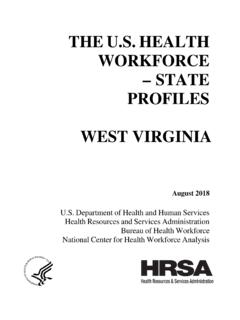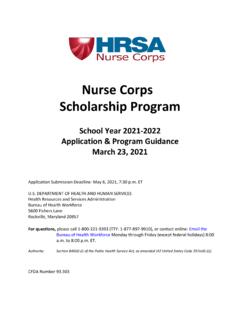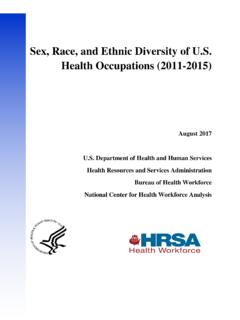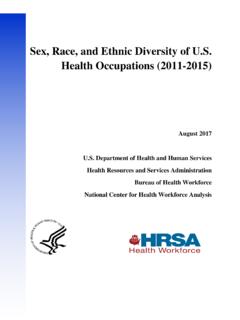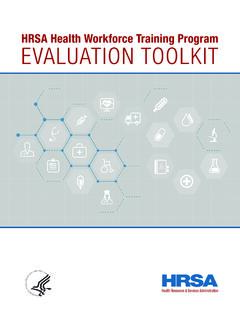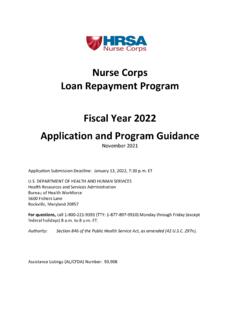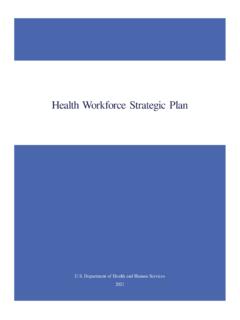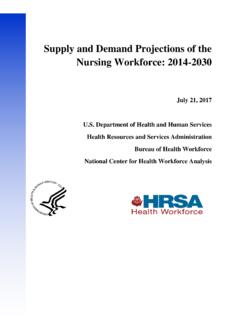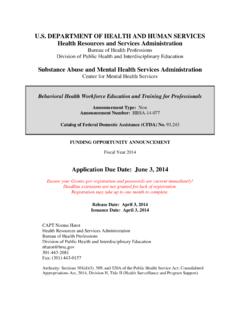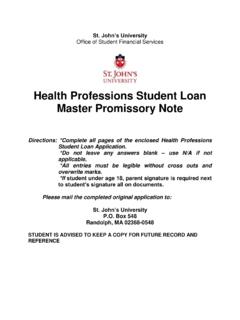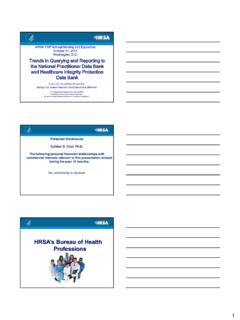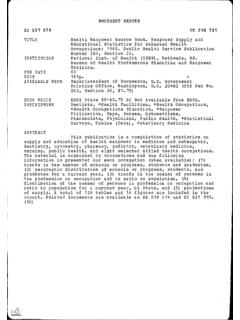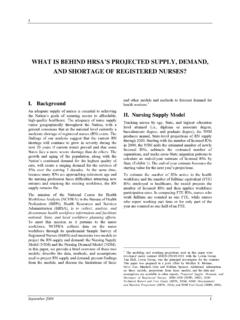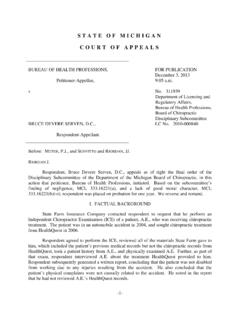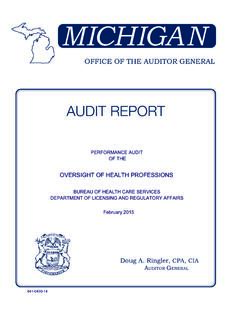Transcription of The U.S. Nursing Workforce: Trends in Supply and Education
1 health Resources and Services AdministrationBureau of health ProfessionsNational Center for health workforce AnalysisThe Nursing workforce : Trends in Supply and Education October 2013 The Nursing workforce : Trends in Supply and Educationii The Nursing workforce : Trends in Supply and Educationiii The health Resources and Services Administration (HRSA), Department of health and Human Services (HHS), provides national leadership in the development, distribution, and retention of a diverse, culturally competent health workforce that can adapt to the population s changing health care needs and provide the highest quality care for all.
2 The agency, through the bureau of health professions , administers a wide range of training grants, scholarships, loans, and loan repayment programs that serve as a catalyst to advance changes in health professions training that respond to the evolving needs of the health care system. The National Center for health workforce Analysis (the National Center) informs public and private-sector decision-making related to the health workforce by expanding and improving health workforce data, disseminating workforce data to the public, improving and updating projections of the Supply and demand for health workers, and conducting analyses of issues important to the health workforce .
3 For more information about the National Center, e-mail us at or visit our website at The Nursing workforce : Trends in Supply and Educationiv The Nursing workforce : Trends in Supply and EducationvContentsEXECUTIVE SUMMARY ..viiINTRODUCTION 1 SECTION 1 The Registered Nurse and Licensed Practical Nurse workforce 3 workforce Size and Distribution 5 Trends in the Nursing workforce During the Past Decade 18 SECTION 2 Nursing Pipeline and Nursing Education Capacity 35 New Entrants to the Nursing Profession 35 Post-Licensure Nurse Education 46 The Nursing Pipeline and Internationally Educated Nurses 52 FiguresFigure 1.
4 The RN workforce per 100,000 Population, by State 10 Figure 2. The per Capita RN workforce , Ranked by State 11 Figure 3. The LPN workforce per 100,000 Population, by State 12 Figure 4. The per Capita LPN workforce , Ranked by State 13 Figure 5. Nurse workforce Distribution in Rural and Urban Areas 14 Figure 6. Nurses per 100,000 Residents in Rural and Urban Areas 14 Figure 7. Growth in the Nursing workforce 19 Figure 8. Highest Degree Held by RNs, Census 2000 and ACS 2008 to 2010 21 Figure 9. The Changing Age Distribution of RNs, in Five-Year Increments 22 Figure 10.
5 Counts of RNs in the workforce , by Age, in Five-Year Increments 23 Figure 11. Race/Ethnicity in the RN workforce and Total Working-Age Population 24 Figure 12. Changing Age Distribution of LPNs, in Five-Year Increments 25 Figure 13. Counts of LPNs in the workforce , by Age, in Five-Year Increments 26 Figure 14. Race/Ethnicity in the LPN workforce and Total Working-Age Population 27 Figure 15. Average Hours Worked by RNs, by Age 32 Figure 16. Average Hours Worked by LPNs, by Age 32 Figure 17. Growth in Full-Time Nurse Salaries 33 The Nursing workforce : Trends in Supply and EducationviFigure 18.
6 NCLEX-RN Passers, 2001 to 2011 .. 37 Figure 19. Growth in NCLEX-RN First-Time Test Takers, by Bachelor s and Non-Bachelor s Degree Status, 2001 to 2011 38 Figure 20. Total Number and Percentage of NCLEX-RN First-Time Test Takers, by Bachelor s and Non-Bachelor s Degree Status, 2001 vs. 2011 39 Figure 21. NCLEX-RN First-Time Test Takers per Capita, 2010 42 Figure 22. NCLEX-PN Passers, 2001 to 2011 .. 43 Figure 23. NCLEX-PN First-Time Test Takers per Capita, 2010 46 Figure 24. Licensed RNs Graduating With BSN Qualification, 2007 to 2011 .. 48 Figure 25. Master s and Doctoral Graduates, 2007 to 2011 49 Figure 26.
7 Nurse Practitioner Graduates, 2001 to 2011 50 Figure 27. Nurse Anesthetist Graduates, 2001 to 2011 51 Figure 28. Newly Certified Nurse Midwives, 2001 to 2011 ..52 Figure 29. Internationally Educated Nurses Passing the NCLEX-RN, 2001 to 2011 54 Figure 30. Internationally Educated Nurses Passing the NCLEX-RN, by Country, 2010 55 Figure 31. Internationally Educated Nurses Passing the NCLEX-PN, 2001 to 2011 56 Figure 32. Internationally Educated Nurses Passing the NCLEX-PN, by Country, 2010 56 TablesTable 1. The RN workforce , by State, per 100,000 Population.
8 5 Table 2. The LPN workforce , by State, per 100,000 Population 7 Table 3. Residential Distribution of the RN workforce Across Urban and Rural Areas 15 Table 4. Residential Distribution of the LPN workforce Across Urban and Rural Areas 17 Table 5. Growth in the per Capita Supply of RNs and LPNs 19 Table 6. Setting of Employment for Nurses, Census 2000 and ACS 2008 to 2010 .. 28 Table 7. Estimated Number of RNs, by Setting of Employment 30 Table 8. Estimated Number of LPNs, by Setting of Employment 31 Table 9. NCLEX-RN First-Time Test Takers, by State and Degree Type, 2010.
9 40 Table 10. NCLEX-PN First-Time Test Takers, by State, 2010 44 The Nursing workforce : Trends in Supply and Educationvii Executive Summary Understanding the Supply and distribution of nurses is key to ensuring access to care and an effective health care system. This report presents data on the Supply , distribution, and Education /pipeline of the Nursing workforce . The data come from a variety of sources and present recent Trends and the current status of the registered nurse (RN) and licensed practical/vocational (LPN) workforces.
10 The report is intended to be used by national and state workforce planners, as well as educators, researchers, and policy makers. The Current Supply of Nurses and Trends Over Time1 There were million RNs (including advanced practice RNs) and 690,000 LPNs in the Nursing workforce that is, working in the field of Nursing or seeking Nursing employment in 2008 to 2010. About 445,000 RNs and 166,000 LPNs lived in rural areas (about 16 percent of the RN workforce and 24 percent of the LPN workforce ). The Nursing workforce grew substantially in the 2000s, with RNs growing by more than 500,000 ( percent) and LPNs by more than 90,000 ( percent).
